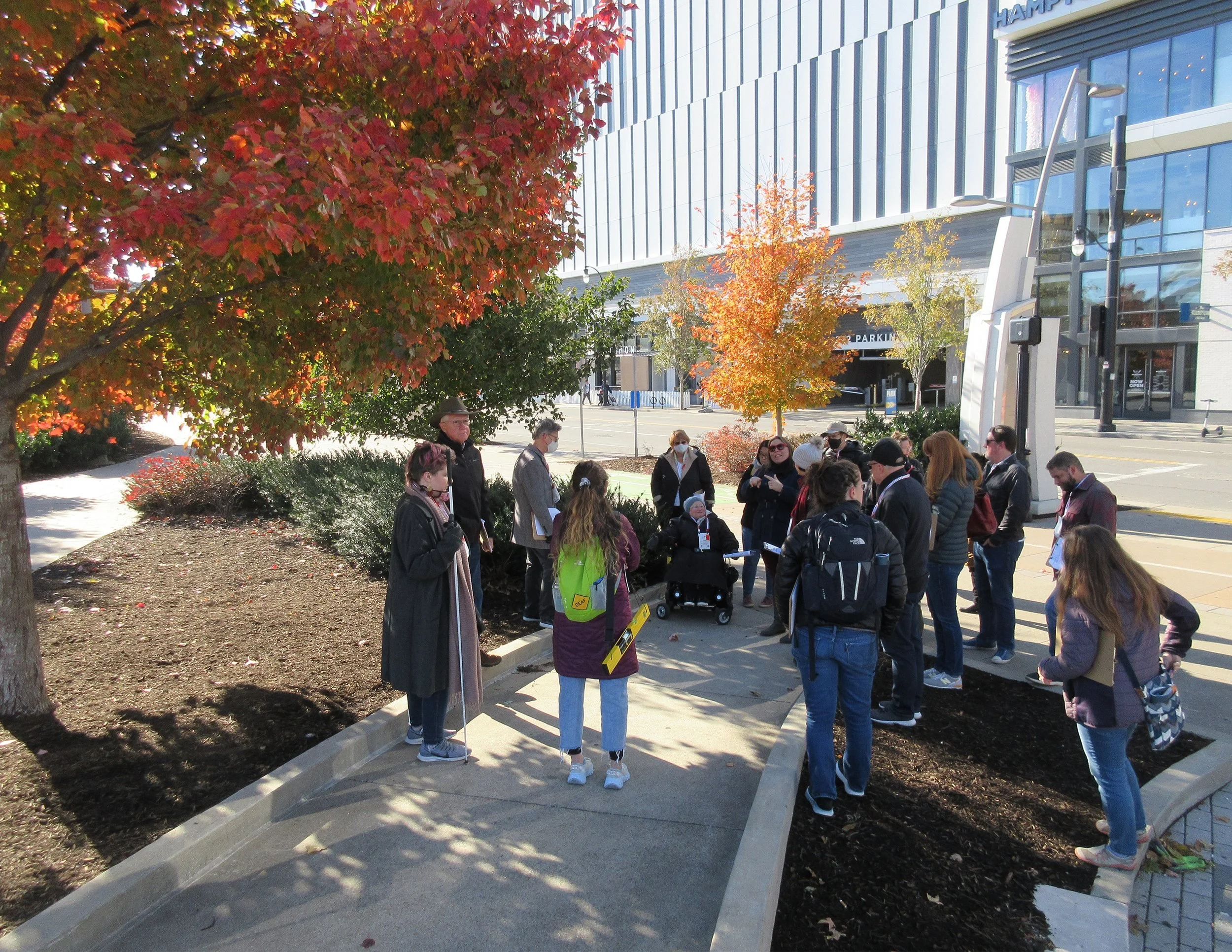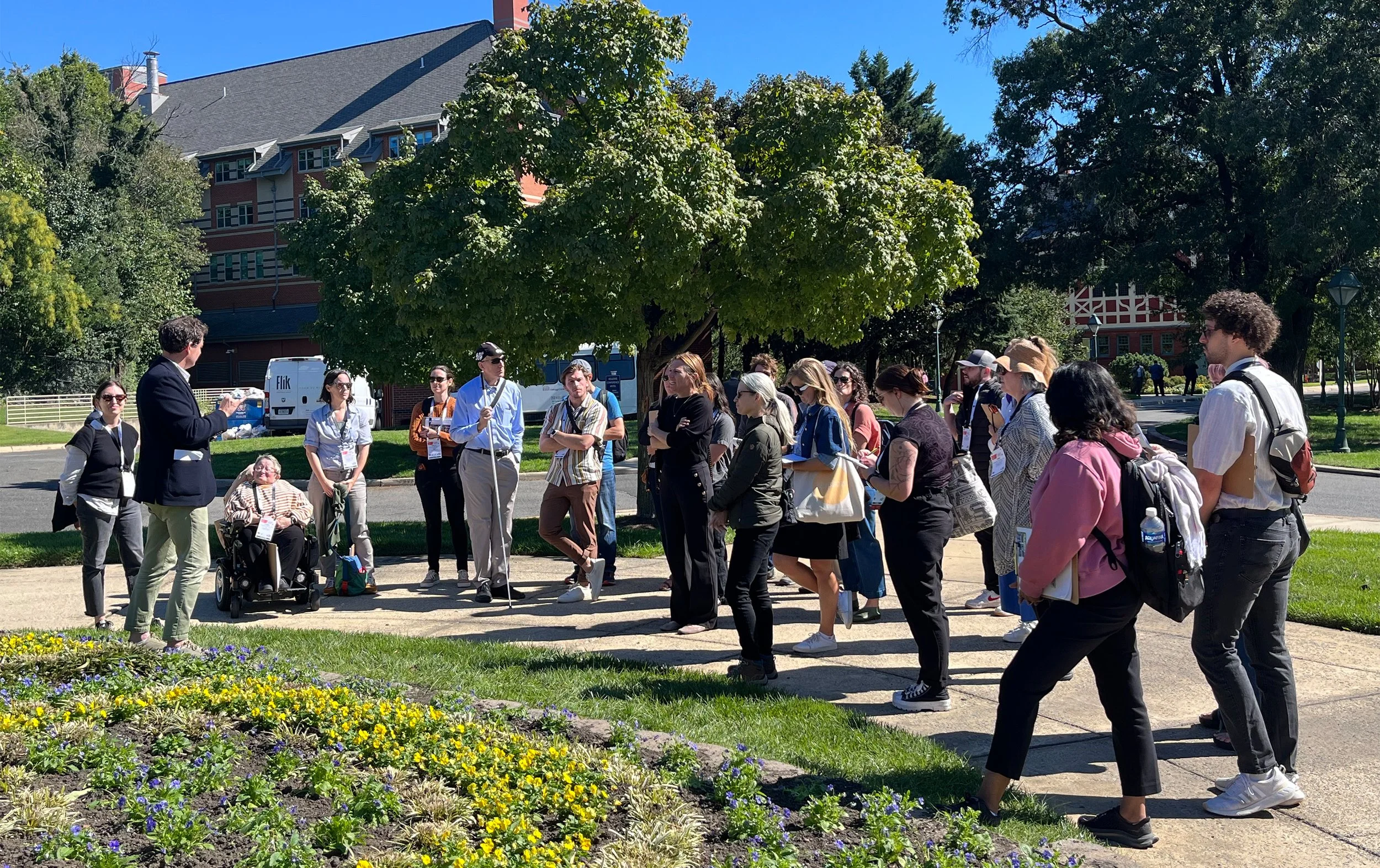How to Conduct an Accessibility Audit
Written & created by: Alexa Vaughn
This toolkit is an abridged version of an article published in Critical Planning Journal, Vol. 28 (Summer 2025).
For comprehensive methodology on accessibility audits, utilized by Alexa and her collaborators, please visit eScholarship for the full article: Accessibility Auditing: Four Case Studies.
What are accessibility audits? How can you incorporate them into your design process?
Accessibility audits are a largely underutilized tool of disabled community engagement in the design process. The design process does not end with construction administration: we must test our designs by conducting accessibility audits with local disabled community members and experts. We need to begin to rethink how we assess site accessibility pre- and post-construction. Between 2021 and 2024, I facilitated four audits with different groups of landscape architects, designers, and students. The methodology I tested in these audits is centered in disability justice and crip theory.
Instead of conducting sensitivity studies (or disability simulations), which are often inappropriate, misguided, and outdated attempts at measuring site accessibility by non-disabled people, designers can conduct audits by directly including disabled stakeholders and experts to prioritize lived experience over assumption in the design process. [Check out The Insensitivity of Sensitivity Studies, an article I wrote for Ground Up Journal, Issue 10.]
Audit Materials
To conduct an access audit, I’ve utilized several materials, including ‘audit packets’ which are printed and made accessible to screen readers in Microsoft Word using simple, clear formatting and alt-text image descriptions. Generally, the packets include:
the session title, date, time, and location to meet
a list of field session leaders and contributors, and relevant titles or occupations, pronouns, and disabled identity (as applicable)
a list of learning outcomes (for Continuing Education Units, or CEUs) if conducting for credit
information on accessibility audits (definition, how and why to conduct)
a selection of accessible and inclusive design elements to consider while on the audit
(various, dependent on the specific design lens being applied)the schedule, with detailed timetables for travel to and between sites and while
conducting each auditsteps on how to conduct the audit
a brief design history of each site to be visited
simple route maps to match the schedule
aerial images of each site to be audited
space for notes and sketches
a list of relevant resources and graphic resources
In addition to a printed packet (or a digital version by request), participants were given a clipboard and a tape measure to take measurements while conducting the audit. During some audits, we also had access to levels, which allowed us to measure slope.
All disabled session contributors should be compensated for their time. Sharing lived experience is a form of expertise and should be treated as a consultancy.
I owe many thanks to the generosity of so many collaborators across these four accessibility audits, to those who helped me to learn along the way how to best put our words into practice, and those who shared their incredible disabled lived experiences across four cities. I especially want to thank: Karen Braitmayer, Dr. Aimi Hamraie, Beth Thielman, Dr. Leann Andrews, Catherine Devereaux, Clareigh Ellis, Jill Moore, Ian Scherling, Andrea LaCour, Elaine Anderson, Justin Bishop, Sam Schuler and his dad Darren, Alma Silver, Derrick Behm, Richard Dougherty, and Jeffrey Mansfield.
Thank you also to all participants who were eager to learn how to integrate the disabled perspective and accessibility audits into their own practice! Accessibility auditing requires allyship and advocacy to make the work happen in real-life projects.
Photograph of one of the access audit groups (approximately 15 people) in Nashville. Everyone is wearing jackets and gathers around a small ramp surrounded by young trees with fall color. Alexa holds a yellow level to measure slope and Karen Braitmayer is visible in her wheelchair next to the ASL interpreter. Image courtesy of Sandra K. Raak, 2021.
Photograph of Alexa leading Penn State students up a ramp with metal rails and surrounded by planters located in front of Recital Hall Plaza on campus. Surrounding trees are bare as they have dropped their leaves for the winter. Everyone wears jackets and some have backpacks. Alexa is visible in the background in a purple jacket with yellow level to measure slope. Image courtesy of Dr. Leann Andrews, 2022.
Photograph of one of the access audit groups (approximately 15 people) in Minneapolis. Everyone is wearing jackets and gathers around a wall with images on it at Peavey Plaza. Jill is visible in the foreground in her wheelchair, with black jacket and beige beanie hat. Image courtesy of Contour Collective, 2023.
Photograph of the access audit group (approximately 20 people) at Gallaudet University. The weather is warm and sunny and everyone gathers around a planted area on campus near the 6th Street Corridor. Richard Dougherty is visible at left in a dark blazer signing to the group, with Alexa to his left in a black vest. Image courtesy of Derrick Behm, 2024.



